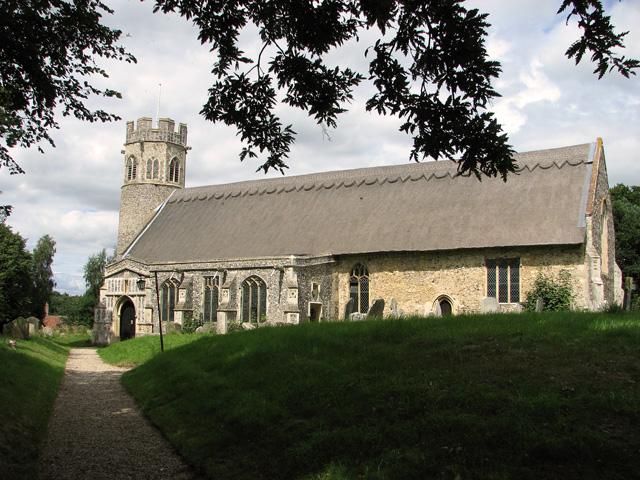St Peter
Westleton, Suffolk
A beautiful, white bareness!

Has one of Suffolk's prettiest round towers, and loveliest thatched roofs and the gargoyles on the south aisle are particularly characterful.
Theberton, Suffolk
On the night of 17th June 1917, on the edge of this village, German Zeppelin airship L48 was brought down, with the agonising death of 16 of its crew. The dead were buried in the graveyard extension here, before being moved to a military cemetery 60 years later; but their memorial remains.
In the porch there is part of the superstructure of the giant airship, incongruous in a glass case. The story below it makes fascinating if slightly harrowing reading.
In the south aisle there is a spectacular memorial to Frederica Doughty, who died in 1843, on the west wall. Beside it is a simple memorial to the explorer and poet Charles Doughty, author of the 1888 work Travels in Arabia Deserta.
Several display cases are devoted to this parish's links with the city of Adelaide in Australia. Colonel William Light, who came from Theberton, surveyed the site for the city, and one of its suburbs is called Thebarton.
The vestry door is kept open to see the Norman north doorway, and the 15th Century font nearby is similar to those at several neighbouring parishes.
A table tomb against the wall, and commemorates John Fenn, the Laudian Rector here in the early 17th century, who was hounded out by the Puritans. He was lucky to escape with his life.
Fenn survived the Commonwealth, and died here after the Restoration of the Church of England. The inscription reads: Here is a stone to sitt upon under which lies in hopes to rise to y day of blisse and happinesse honest John Fenn, the sonne of William Fenn, Clarke and late Rector of this parish. Being turned out of this living and sequestered for his loyalty to the late King Charles the First hee departed this life the 22 day of October anno domini 1673.
Westleton, Suffolk
A beautiful, white bareness!
Knodishall, Suffolk
Sibton, Suffolk
A church building full of atmosphere that clearly demonstrates its complex development and many associations through its 800 years existence.